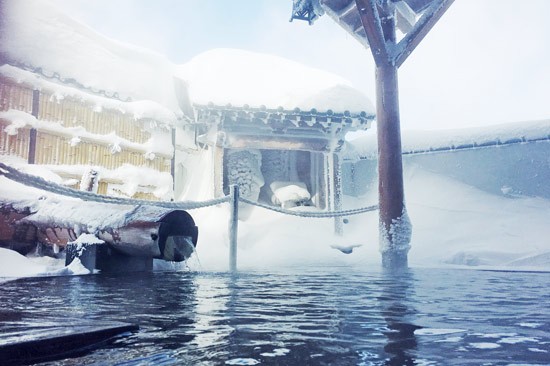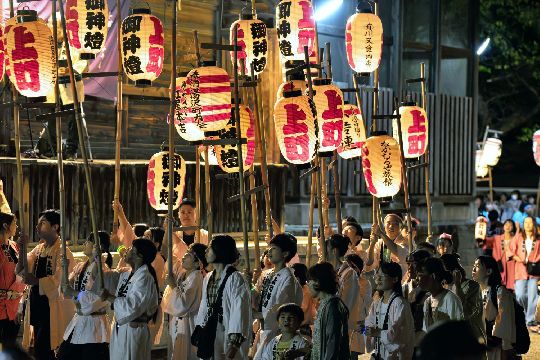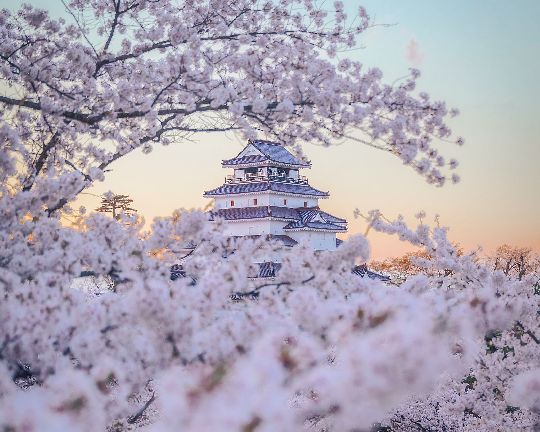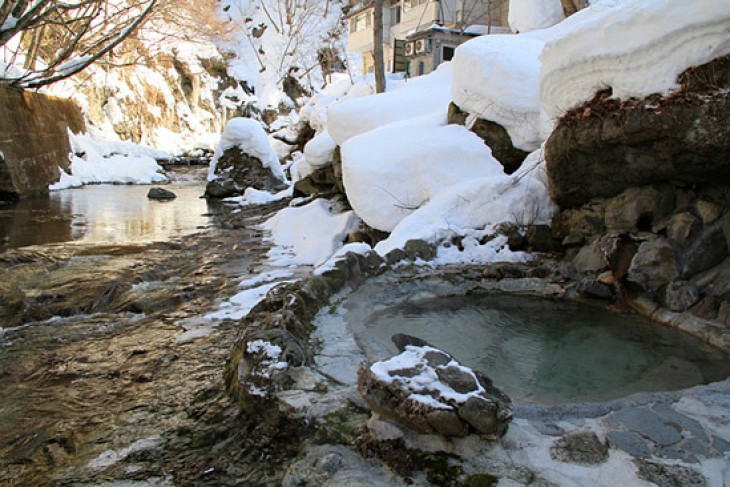
In this article, I’m going to introduce you to a number of traditional Japanese inns (ryokan) in onsen towns throughout Fukushima where you can experience the magic of private rotenburo outdoor baths.
WHAT ARE ROTENBURO?
'Rotenburo' translates as ‘open-air bath’.
The word refers to onsen baths that are located fully or partially outside. Depending on the location, bathers might be sheltered from the elements to some extent by roofs and bamboo walls, trees, glass windows etc. Rotenburo are very popular in Japanese onsen towns, especially during the winter months, when guests can enjoy bathing in a hot bath whilst surrounded by snowy mountains.
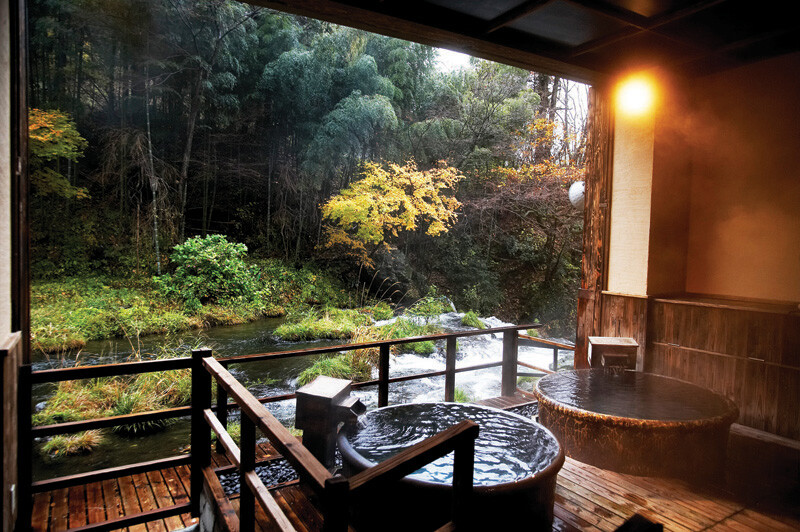
WHY USE PRIVATE BATHS?
At ryokan hotels in Japan, it is common to bathe together with other guests of the same sex, and in some cases, together with guests regardless of sex. There are, however, many people who prefer to bathe alone, or in the company of friends, family and loved ones. This is one of the main reasons why people use private baths, or ‘kashikiri buro‘.
Another reason is that Japan has a long history of tattoos being associated with gangsters known as yakuza. Of course, the majority of tattoo designs don’t resemble those traditional ones sported by yakuza, but even so, it has remained taboo to enter a public (or shared) bath if you have a tattoo. Although many ryokan turn a blind eye to this rule, it’s still the official policy of many ryokan and hotel in Japan to turn away guests with tattoos from using baths shared with other guests.
In order to avoid any drama, and any potential stares, many tourists from overseas choose to use private baths when they stay at ryokan hotels. Private baths can usually be booked at the front desk of the ryokan hotel, and guests are usually asked to choose a specific time to bathe.
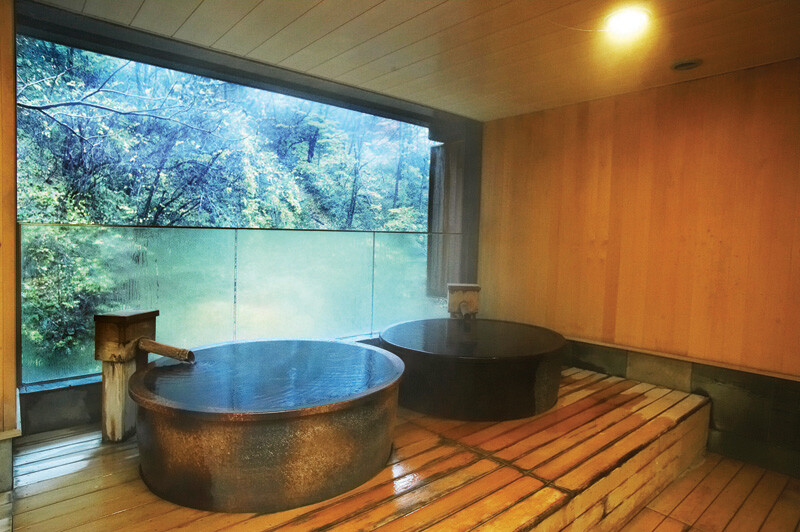
WHICH RYOKAN IN FUKUSHIMA PREFECTURE HAVE PRIVATE OPEN-AIR BATHS?
There are around 130 hot springs in Fukushima Prefecture and hundreds of ryokan hotels. In order to make a list of suggestions, I’ve had to cut this number down quite a lot.
I’ve decided to highlight the ryokan hotels in Fukushima Prefecture where guests can book private rotenburo, giving priority to those with English websites or associated websites which make it easy to book even if you don’t speak Japanese. There are so many amazing ryokan in Fukushima Prefecture, and this list is by no means extensive.
| Ryokan Hotel | Private Rotenburo (Overnight Guests) | Private Rotenburo (Day Guests) | English Website | Price |
| 1) Harataki
(Higashiyama Onsen, Aizu) |
|
2000 yen (50 min) | ||
| 2) Takinoyu
(Higashiyama Onsen, Aizu) |
No extra cost for overnight guests | |||
| 3) Seifutei
(Bandaisan Roku Onsen, Inawashiro) |
(Computer translation) |
No extra cost for overnight guests | ||
| 4) Okawaso
(Ashinomaki Onsen, Aizu) |
3240 yen (45 min) | |||
| 5) Yoshikawaya
(Iizaka Onsen, Fukushima City) |
2160 yen (45 min) + 1000 yen per person for day visit | |||
| 6) Kikuya Ryokan
(Iizaka Onsen, Fukushima City) |
30 min for free | |||
| 7) New Ougiya
(Tsuchiyu Onsen, Fukushima City) |
No extra cost for overnight guests | |||
| 8) Sansuiso
(Tsuchiyu Onsen, Fukushima City) |
1080 yen (60 min) | |||
| 9) Yumori Onsen Hostel
(Tsuchiyu Onsen, Fukushima City) |
|
(Responds in English to Facebook messages) |
2000~4000 yen per bath for overnight guests. | |
| 10) Furutakiya
(Yumoto Onsen, Iwaki) |
(Computer translation) |
1000 yen (45 min) + 800 yen per person |
AIZU AREA
Aizu is known for its very snowy winters and long history.

1) Harataki
- A tattoo-friendly ryokan hotel in Higashiyama Onsen, Aizu-Wakamatsu City.
- Day-guests and overnight-guests can use the private open-air baths.
- When I stayed a couple of years ago, they even had CD players so you could play music while you bathed!
- More information on Fukushima.Travel
- English website here
2) Takinoyu
- Also located in Higashiyama Onsen.
- Private rotenburo open-air baths are free to book for overnight guests at Takinoyu Ryokan Hotel.
- More information on Fukushima.Travel
- English website here
3) Seifutei
- Every room at this ryokan in Inawashiro Town has its own en-suite open-air private bath so you don’t even have to worry about booking time-slots for going in the bath.
- Their homepage has an automatic translation function.
- Seifutei can also be found on Booking.com & other booking sites.
4) Ookawaso
- Ookawaso ryokan is in Ashinomaki Onsen town (the town is known for it’s cat station master)!
- Ookawaso has a great selection of food at its dinner buffet, which is really good for those who don’t want to be forced into eating a specific, Japanese-style meal.
- Overnight guests can book and pay an extra price to use the open-air private baths, but only 4 groups can make a booking each night, due to time and space restrictions.
- Reservations in English can be made directly via email, or through a booking website.
- More information on Fukushima.Travel
- Here is their homepage.
NAKADORI AREA
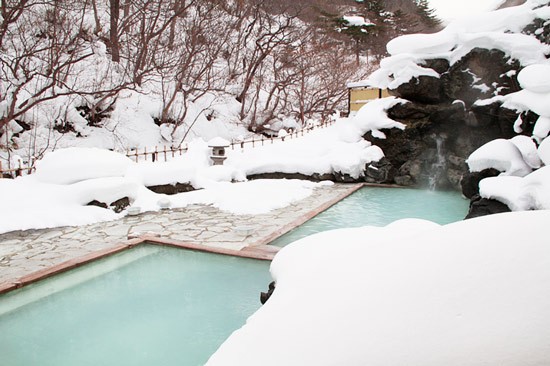
Ryokan hotel in the central region of Fukushima Prefecture.
5) Yoshikawaya
- Large ryokan hotel in Iizaka Onsen, near central Fukushima Station.
- Yoshikawaya Ryokan welcomes guests during the day and evening to use its open-air baths.
- It costs 2160 yen for each group to book the private bath for 45 minutes, as well as a 1000 yen charge per person.
- They’re featured on a number of booking sites.
- More information on Fukushima.Travel
- English homepage
6) Kikuya Ryokan
- Ryokan in Iizaka Onsen.
- Kikuya Ryokan offers guests who stay the night a free 30 minutes in the private open-air bath, as well as the chance to dip in all the other baths.
- Their website is machine translated but is ok to understand. They are also featured on some booking sites where bookings can be conducted in English.
- Machine-translated English homepage
7) New Ougiya
- New Ougiya Ryokan in Tsuchiyu Onsen, Fukushima City has private open-air baths free for overnight guests to use.
- They’re featured on a couple of English-language booking sites.
- They also have an English website.
8) Sansuiso
- Large ryokan hotel in Tsuchiyu Onsen.
- Overnight guests can bathe for 1 hour in a private half-covered open-air bath for 1080 yen.
- Featured on English-language booking sites.
- More information on Fukushima.Travel
- See their English homepage here.
9) Yumori Onsen Hostel
- Recently-opened hostel in Tsuchiyu Onsen with very reasonable prices.
- Tattoo friendly onsen.
- They have English-speaking staff who can answer any questions you might have via their Facebook Page (See here).
- See their homepage here.
IWAKI AREA
Iwaki has much milder winters than the western and central part of Fukushima Prefecture, so visit Iwaki if you want to avoid the snow as much as possible!
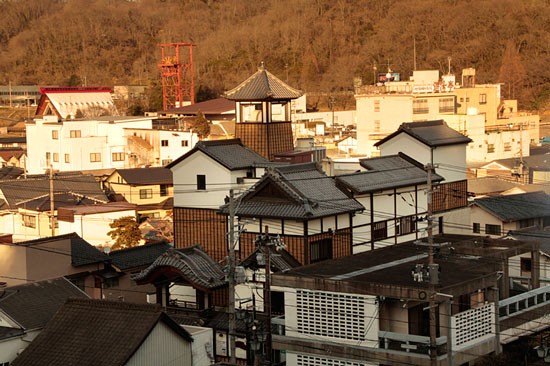
10) Furutakiya
- In scenic Iwaki Yumoto Onsen town by the coast.
- Private open-air baths can be reserved by overnight guests and day-guests.
- This ryokan has private open-air baths that can be rented for 1000 yen per 45 minutes (plus 800 yen per person for day-guests).
- Featured on English-language booking websites.
- Automatic-translation available on their website
